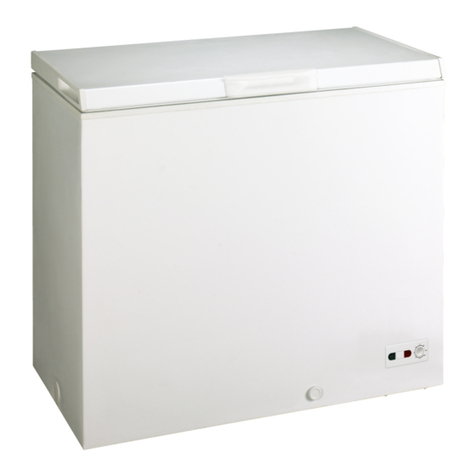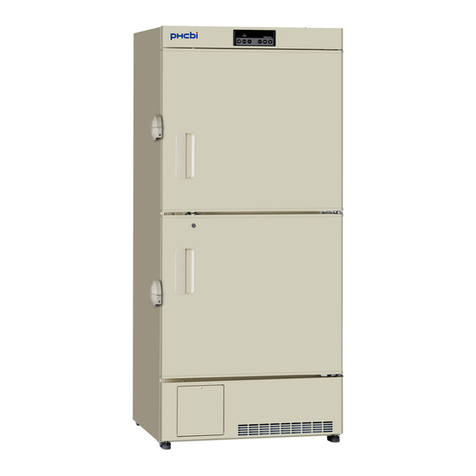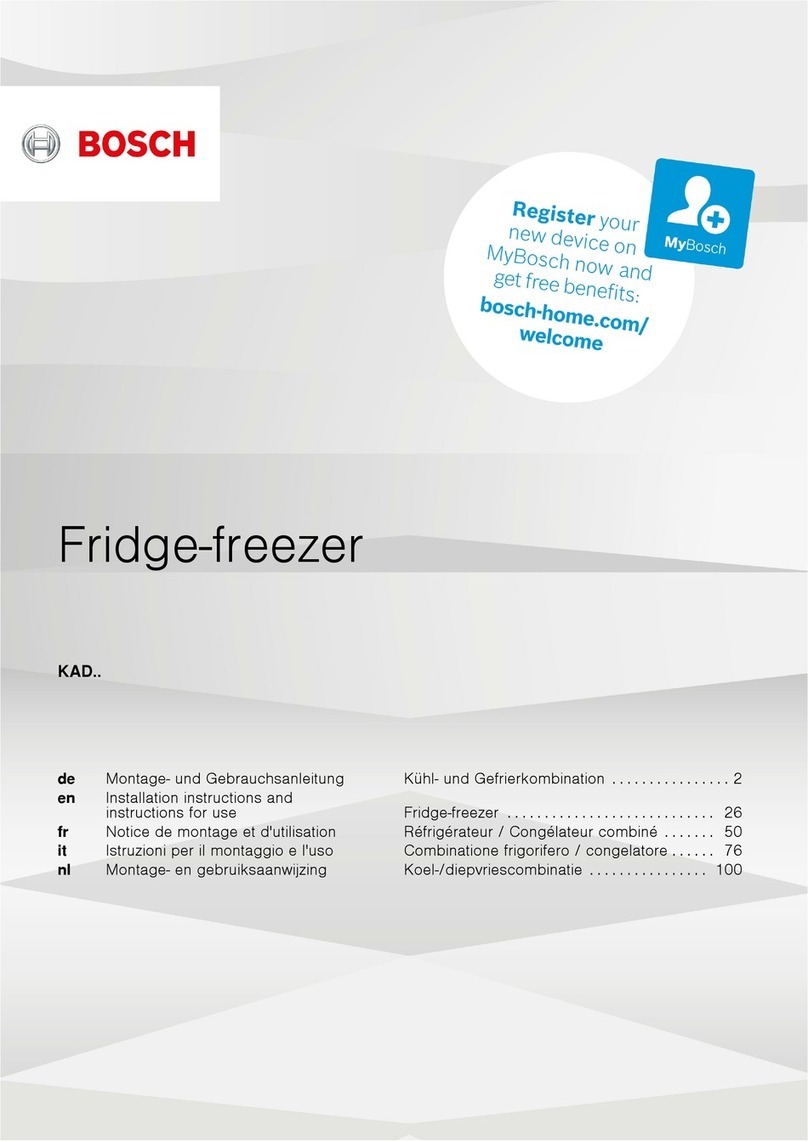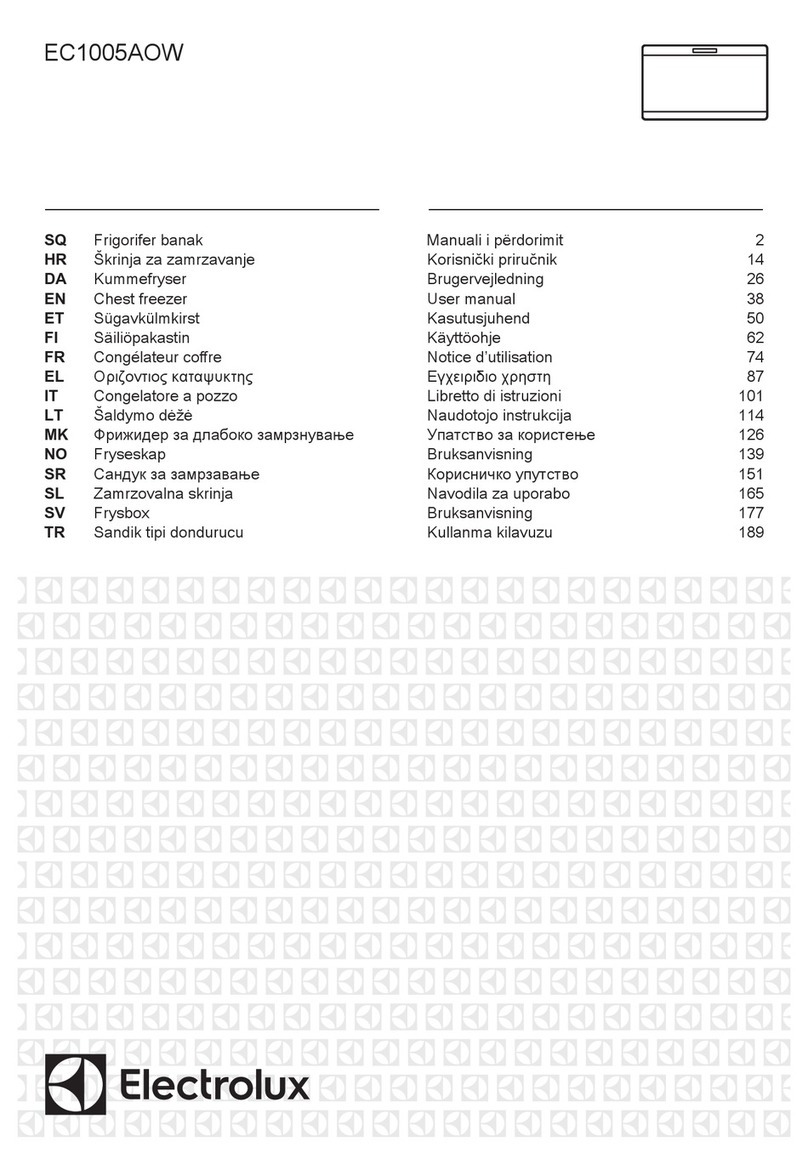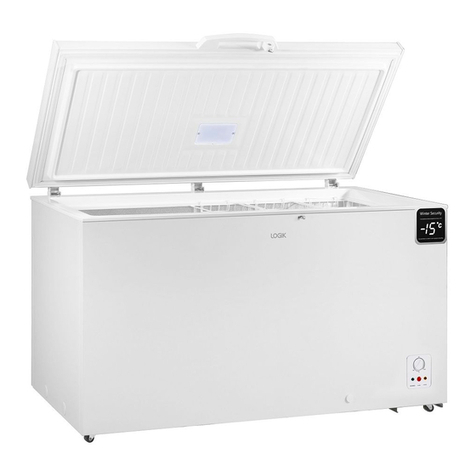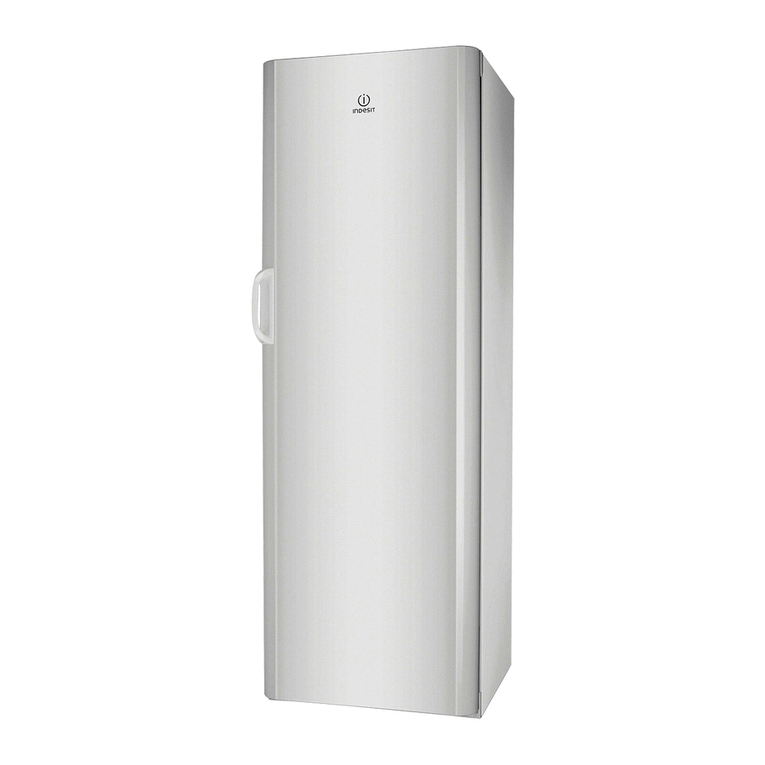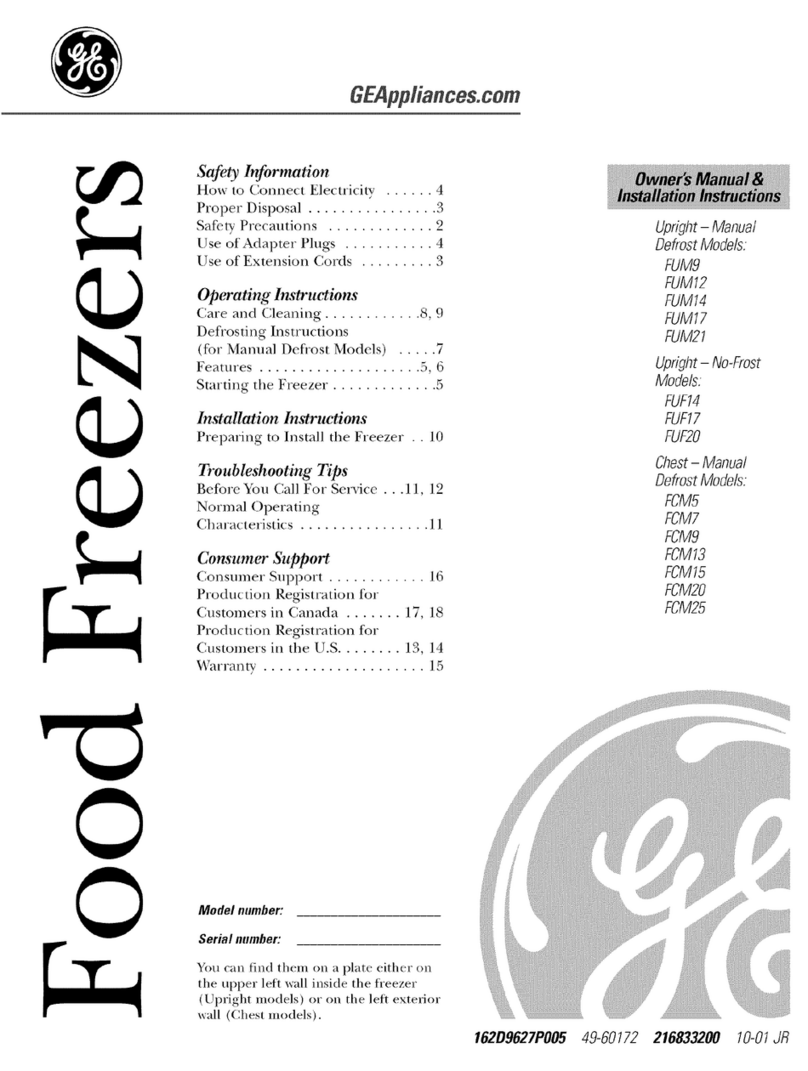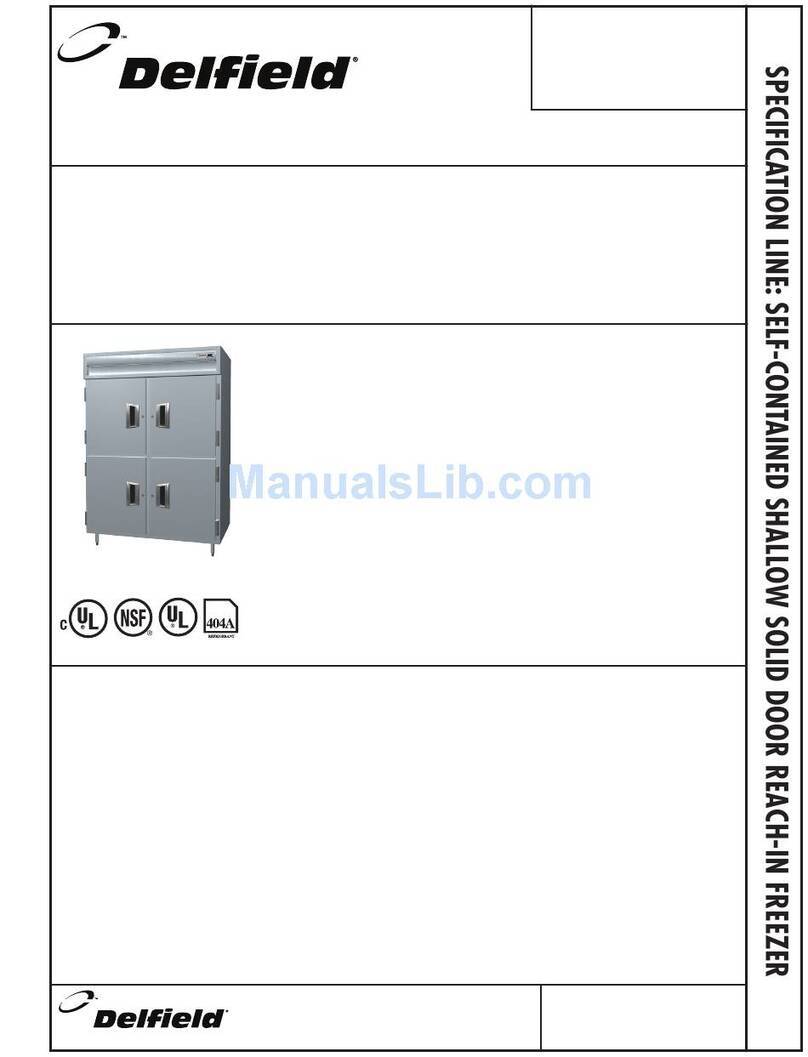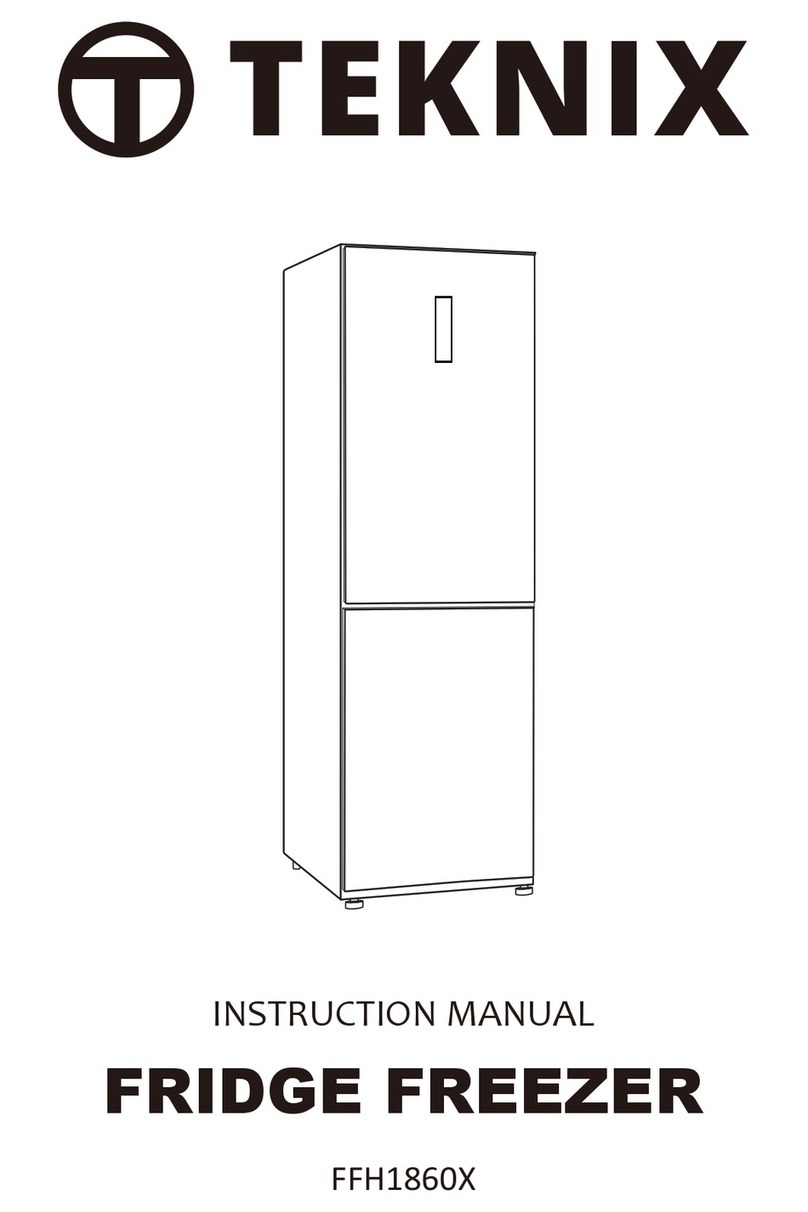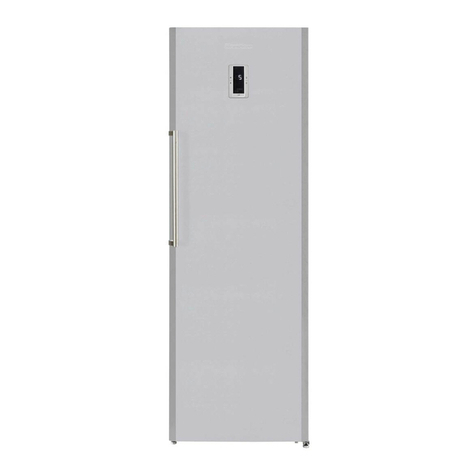Trieste ED-PF180L User manual

1
Trieste
Instruction Manual
Upright Freezer
MODEL: ED-PF180L

2
Dear customer:
Thank you for buying this upright freezer. To ensure that you
get the best results from your new freezer, please take time to
read through the simple instructions in this booklet.
Please ensure that the packing material is disposed of in
accordance with the current environmental requirements.
When disposing of any fridge equipment please contact your
local waste disposal department for advice on safe disposal.
This appliance must be only used for its intended purpose.
INSTALLING YOUR REFRIGERATOR
User should take out the door handle in the plastic bag, and install it
into the door. Then take out the two handle stopples and cover the
installed screws with them. The handle stopple and screw stopple in the
plastic bag can be used when the user wants the door to be opened from
left.
UNPACKING YOUR REFRIGERATOR
WARNING: Use two or more people to move fridge.
Failure to do so can result in back or other injury.
·Remove tape and any labels from your fridge before using(except
the rating label).
To remove any remaining tape or glue, rub the area briskly with
your thumb.

3
Tape or glue residue can also be easily removed by rubbing a
small amount of liquid dish soap over the adhesive with your
fingers. Wipe with warm water and dry.
·Do not use sharp instruments, rubbing alcohol, flammable fluids, or
abrasive cleaners to remove tape or glue. These products can
damage the surface of your refrigerator.
·When moving the refrigerator, do not tilt the refrigerator beyond 45°
from upright position.
CLEANING BEFORE USE:
After you remove all of the packaging materials, (especially the
foam between outside condenser and cabinet should be removed)
clean the inside of your fridge before using it.
SPACE REQUIREMENTS
WARNING: Keep flammable materials and vapors, such as
gasoline, away form fridge.
Failure to do so can result in death, explosion, fine or burns.
·To ensure proper ventilation for your fridge, allow for 200mm space
on each side between walls, 100mm space between back of your
fridge and the wall, and 300mm space between counter top and
the roof or ceiling.
·If you are installing your fridge next to a fixed wall, leave sufficient
space on the hinge side to allow for the door to swing open.
·Never install your fridge near heat source and direct sun shins.
ELECTRICAL REQUIREMENT
WARNING: DO NOT REMOVE GROUND PRONG.
DO NOT USE AN ADAPTOR.

4
DO NOT USE EXTENSION CORD.
Failure to follow these instructions can result in death, fire or electrical
shock.
Before you move your refrigerator into its final location, it is important
to make sure you have the proper electrical connection.
Recommended Earthing Method
A 220~240 Volt /50 Hz AC only 10 ampere fused and properly
earthed electrical supply is required. It is recommended that a
separate circuit serving only this appliance be provided. Use a
receptacle which cannot be turned off with a switch or pull chain. Do
not use an extension cord.
NOTE: Before performing any type of installation, disconnect the
fridge from the electrical source. When you are finished, connect the
fridge to the electrical source and reset the control to the desired setting.
LEVELING
If the fridge is not leveled during installation. The doors may not
close or seal properly, causing cooling, frost, or moisture problems. It
is very important of the fridge to be level in order to function properly.
To level your fridge you may either turn the level leg clockwise to
raise that side to the fridge or turn counter –clockwise to lower that
side.
NOTE: Having someone push against the top of the fridge take some
weight off the leveling leg. This makes it easier to adjust the leveling
leg.
USE OF THE APPLIANCE
To obtain the best possible results form your refrigerator, it is important

5
that you operate it properly.
before using, here is the brief instruction: red light: operation of
compressor; green light: power; yellow light: warning of temp.
exceeding
Temperature Control
The temperature in the freezer is controlled by the thermostat control
knob in front of the top cover. Turn the thermostat control knob up
or down to regulate the temperature inside the freezer. The markings
on control knob indicated the “MIN, MAX” for the different
temperature grades. The temperature decreases with position MIN
being the warmest and position MAX being the coldest.
Set the control to position between “MIN”and “MAX”for normal use,
the exact postion is beyond the temperature in the freezer,
generally ,it is in the middle.
Store Frozen Food
When using the freezer for the first time or after defrosting, turn the
temperature control to set MAX for at least two hours before
introducing the food to be stored.
All frozen food products you purchase should be placed in the
freezer as soon as possible to avoid the frozen food from defrosting.
Storage recommendation printed on the packaging of frozen food by
the manufacturers should be always be followed.
Be careful that the drawer mustn’t mangle the refrigeration pipeline
Freezing Fresh Food
Ensure that your freezing operations are carried out under the most
hygienic conditions as freezing alone does not sterilize the food. It is
advisable to freeze the food by packing it into separate meal portions
and not in bulk form. Never put hot or even warm foodstuffs into the

6
freezer. Prior to storing the frozen food, pack it in plastic bags,
aluminum sheets or freezing containers and place into the freezer.
See the data sheet at the rear of this booklet for the maximum
permissible amount in kilograms of fresh food that can be frozen in
any 24 hour period with a room temperature of 25℃. Never freeze
more than the maximum permissible.
Note: Never put bottled food or drinks in the freezer compartment.
.For best performance, leave enough space in the fridge
compartment for air to circulate around the packages.
Defrosting
Remove the mains plug from the wall socket, open the door and
remove all the food to a cool place. Defrost using a plastic scraper, or
let the temperature rise naturally until the frost melts. Then wipe
away the remaining ice and water, after this plug the freezer back
into the mains supply.
Note: To avoid damaging the freezing compartment wall, do not use
any sharp objects to remove the frost or separate the frozen
food.
Cleaning your freezer
Before you start to clean your freezer remove the mains plug from
the power supply.
Use a clean sponge or soft and a mild detergent in warm water. Do
not use abrasive or harsh cleaners.
Hand wash, rinse and dry all surfaces thoroughly.
Do not use cleaning waxes, concentrated detergents, bleaches or
cleaners containing petroleum on plastics and rubber parts.
Never use paper towels, window sprays, scouring cleansers or
flammable fluids on plastic parts as these can scratch or damage

7
material.
Clean with a cloth soaked in this solution and then dry with a soft
cloth.
PROLONGED OFF PERIODS
If the freezer is not in use for a long period of time, proceed as
follows:
Disconnect the freezer from the main supply by removing the plug
from the wall socket.
Clean and dry the inside as instructed under the heading of cleaning
the fridge.
Leave the door open to prevent any unpleasant smells from building
up while the freezer is not in use.
TROUBLESHOOTING
In case of malfunction, you can solve many common problems
easily.
Your refrigerator will not operate…Check if
-- The power supply cord is unplugged.
The doors will not close completely…Check if
-- The drawers are out of position.
-- The gaskets are dirty.
-- The refrigerator is not level.
The freezer is noisy when running…Check if
-- Check the freezer is level and it is not in contact with another
appliance or kitchen furniture.
The freezer does not cool sufficiently…Check if
-- If the door has been opened too often, or it has been left open

8
for a while it will take time for the freezer to reach its set
temperature.
-- Check the airflow the rear of the freezer has not been reduced
due to insufficient clearance.
The following characteristics should not be looked upon as a
problem.
-- A gentle tricking sound caused by coolant flowing the pipe.
Compressor operating at high temperature.
WARNNING
--the appliance is not intended for use by young children or infirm
persons without supervision.
-- young children should be supervised to ensure that they do not
play with the appliance
--This appliance is not intended for use by persons (including children)
with reduced physical, sensory or mental capabilities, or lack of
experience and knowledge, unless they have been given supervision or
instruction concerning use of the appliance by a person responsible for
their safety.
-- Do not use electrical appliances inside the food storage compartments
of the appliance, unless they are of the type recommended by the
manufacturer.
-- Do not damage the refrigerant circuit.
-- Do not use mechanical devices or other means to accelerate the
defrosting process, other than those recommended by the manufacturer.
-- The instructions shall state that the appliance has to be unplugged
after use and before carrying out user maintenance on the appliance.
-- If the supply cord is damaged, it must be replaced by the
manufacturer, its service agent or similarly qualified persons in order to
avoid a hazard.

9
For household refrigerating appliances
Try not to open the door too often, especially when the weather is
wet and hot. Once you open the door, mind to close it as soon as
possible.
Every now and then check if the appliance is sufficiently ventilated
(adequate air circulation behind the appliance).
For household refrigerating appliances, in normal temperature
conditions, please arrange the thermostat at the middle setting.
Before loading the appliance with packages of fresh foods, make
sure they are cooled to ambient temperature.
Ice and frost layer increase energy consumption, so do clean the
appliance as soon as the layer is 3-5 mm thick.
If it is the outer condenser, the rear wall should be always clean, free
of dust or any impurities.
Always consider instructions stated in sections Positioning and
Energy Saving Tips, otherwise the energy consumption is
substantially higher.
For household refrigerating appliances
Try not to open the door too often, especially when the weather is
wet and hot. Once you open the door, mind to close it as soon as
possible.

10
Every now and then check if the appliance is sufficiently ventilated
(adequate air circulation behind the appliance).
For household refrigerating appliances, in normal temperature
conditions, please arrange the thermostat at the middle setting.
Before loading the appliance with packages of fresh
foods, make sure they are cooled to ambient temperature.
Ice and frost layer increase energy consumption, so do clean the
appliance as soon as the layer is 3-5 mm thick.
If it is the outer condenser, the rear wall should be always
clean free of dust or any impurities.
Always consider instructions stated in sections Positioning and
Energy Saving Tips, otherwise the energy consumption is
substantially higher.
REQUESTINGASSISTANCE OR SERVICE
If the problem is not due to one of the items listed in
Troubleshooting, Contact the dealer or authorized Service
Company.
Table of contents
